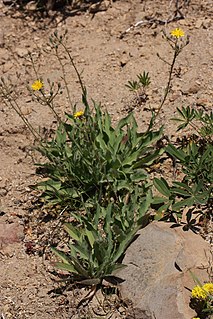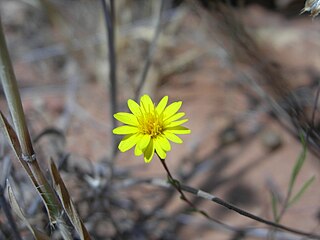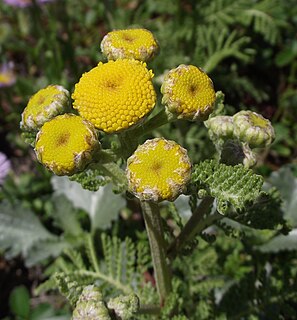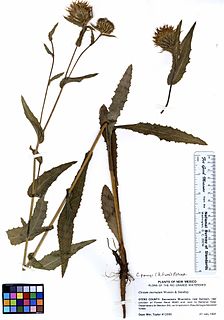
Hieracium , known by the common name hawkweed and classically as hierakion, is a genus of flowering plant in the family Asteraceae, and closely related to dandelion (Taraxacum), chicory (Cichorium), prickly lettuce (Lactuca) and sow thistle (Sonchus), which are part of the tribe Cichorieae. Hawkweeds, with their 10,000+ recorded species and subspecies, do their part to make Asteraceae the second largest family of flowering plants. Some botanists group all these species or subspecies into approximately 800 accepted species, while others prefer to accept several thousand species. Since most hawkweeds reproduce exclusively asexually by means of seeds that are genetically identical to their mother plant, clones or populations that consist of genetically identical plants are formed and some botanists prefer to accept these clones as good species whereas others try to group them into a few hundred more broadly defined species. What is here treated as the single genus Hieracium is now treated by most European experts as two different genera, Hieracium and Pilosella, with species such as Hieracium pilosella, Hieracium floribundum and Hieracium aurantiacum referred to the latter genus. Many members of the genus Pilosella reproduce both by stolons and by seeds, whereas true Hieracium species reproduce only by seeds. In Pilosella, many individual plants are capable of forming both normal sexual and asexual (apomictic) seeds, whereas individual plants of Hieracium only produce one kind of seeds. Another difference is that all species of Pilosella have leaves with smooth (entire) margins whereas most species of Hieracium have distinctly dentate to deeply cut or divided leaves.
A dry roadside dotted with small, ¾ inch red orange flowers, interspersed with very similar yellow ones, and often the white of daisies, is a good sign that you are in Hawkweed country.

Hieracium lachenalii, also known as common hawkweed or yellow hawkweed, is a species of plant in the tribe Cichorieae within the family Asteraceae. It is native to Europe but has become established as a weed in Australia and parts of North America. The species was widely known for many years as H. vulgatum, but more recent studies have indicated that the two names represent the same species. The name H. lachenalii was coined in 1802, H. vulgatum in 1819, so the older name is to be used.

Pilosella caespitosa is like several other Pilosella species and has a similar appearance to many of the hawkweeds.

Grindelia stricta is a species of flowering plant in the family Asteraceae known by the common names Oregon gumplant, Oregon gumweed and coastal gumplant. It is native to the west coast of North America from California to Alaska, where it is a resident of coastal plant communities such as those in marshes and beaches. This plant is variable in appearance, taking the form of a weedlike perennial herb forming low clumps to a sprawling subshrub growing erect to heights exceeding one meter. Its foliage and stems are green to rusty red or purplish and the plant may be hairy to hairless. The fleshy leaves are green, often with red edges and veining, and are up to 15 centimeters in length on large plants. The inflorescence holds one or more flower heads each up to 5 centimeters wide. The flower head is a cup of thick erect or recurved green phyllaries. Yellow disc florets fill the center of the flower head and there is a fringe of yellow ray florets around the circumference. The head produces copious amounts of white latex, especially in the early stages of blooming.

Pilosella scouleri is a North American species of flowering plant in the tribe Cichorieae within the family Asteraceae. It is known as Scouler's woollyweed. It is native to western North America, from British Columbia and Alberta in Canada, south to northern California and Utah in the United States.
Senecio transmarinus is a sometimes straggling member of the flowering plants Asteraceae and species of the genus Senecio a perennial herb that grows on the higher elevations of the Rwenzori Mountains in Uganda. It is also found in Rwanda and the Democratic Republic of the Congo. The inflorescences consist of several flowerheads with large yellow ray florets.
Senecio mattirolii is a perennial herb of the family Asteraceae endemic to altitudes between 3600–4500 meters on the slopes of the mountains of the Ruwenzori Mountains in Uganda and the Democratic Republic of the Congo and an atypical species of the genus Senecio because it has purple flowers.

Leontodon taraxacoides is a species of hawkbit known by the common name lesser hawkbit, rough hawkbit, or hairy hawkbit. It is native to Europe and North Africa but it can be found in many other places across the globe as an introduced species and often a noxious weed. This is a dandelion-like herb growing patches of many erect, leafless stems from a basal rosette of leaves. The leaves are 2 to 15 centimeters long, 0.5 to 2.5 centimeters wide, entire or lobed, and green in color. Atop the stems are solitary flower heads which are ligulate, containing layered rings of ray florets with no disc florets. The florets are yellow with toothed tips. The fruit is a cylindrical achene with a pappus of scales. Fruits near the center of the flower head are rough, while those growing along the edges of the head are smooth.

Chaenactis artemisiifolia, with the common name white pincushion, is a species of flowering plant in the daisy family. It is native to the coastal Peninsular Ranges of Southern California and Baja California, in the chaparral and woodlands.

Agoseris apargioides is a species in the family Asteraceae, is commonly called seaside agoseris or seaside false-dandelion. It is native to the Pacific coast of the United States from Washington to central California, where it grows primarily on coastal dunes.
Erigeron sanctarum is an uncommon species of flowering plant in the family Asteraceae known by the common names saints fleabane and saints daisy. It is endemic to California, where it is known from San Luis Obispo and Santa Barbara Counties including two of the Channel Islands.

Hazardia brickellioides is a species of shrub in the family Asteraceae known by the common name brickellbush goldenweed. It is native to the Mojave Desert of California and Nevada, where it grows in rocky limestone habitat.
Madia radiata is a species of flowering plant in the family Asteraceae known by the common names golden madia and showy madia. It is endemic to California, where it is known mostly from the Central Coast Ranges and adjacent edges of the San Francisco Bay Area and Central Valley.

Blepharizonia is a genus of flowering plants in the family Asteraceae. There are two species, both endemic to California. They are known generally as big tarweeds.

Pentachaeta aurea is a species of flowering plant in the aster family known by the common names golden-rayed pentachaeta, golden chaetopappa, and golden leastdaisy. It is native to southern California, where it grows in the San Gabriel and San Bernardino Mountains and the Peninsular Ranges, and northern Baja California. It is an annual herb with a hairy stem reaching a maximum height near 36 centimeters from a slender taproot. The narrow linear leaves are up to 5 centimeters long but only a few millimeters wide and may be very hairy. The inflorescence is a solitary flower head, with up to 22 heads per plant. The flower head bears many yellow, brownish, or whitish ray florets 3 to 12 millimeters long, and has a center of many five-lobed yellow to reddish disc florets. The fruit is an achene tipped with a pappus of bristles.

Perityle inyoensis, known by the common names Inyo rockdaisy and Inyo laphamia, is a rare species of flowering plant in the aster family.

Tanacetum camphoratum is a species of flowering plant in the aster family known by the common names camphor tansy and dune tansy. It is native to the Pacific Coast of North America from British Columbia to California, where it grows in sand dunes and other coastline habitat. This species may be known by the synonym Tanacetum douglasii and is often included in Tanacetum bipinnatum. It is a rhizomatous perennial herb with a thick, low-lying stem up to 25 centimeters long, branching to form a mass of vegetation. It is hairy, glandular, and aromatic, with a camphor scent. The leaves are up to 25 centimeters long and thick but featherlike, divided into many narrow leaflets on each side of the main rachis. Each leaflet in turn has many segments along each side, and the segments are usually divided into several small, knobby segments with folded or curled edges. The inflorescence bears up to 15 flower heads, each about a centimeter wide or slightly wider. Each head contains many yellowish disc florets and many pistillate florets around the edges. The latter may have minute ray florets. The fruit is an achene a few millimeters long which is tipped with a small pappus of toothed scales.

Heterotheca shevockii is a rare species of flowering plant in the family Asteraceae known by the common names Kern Canyon false goldenaster and Shevock's goldenaster. It is endemic to California in the United States, where it is known only from Kern County. It grows along a 21-mile stretch of the Kern River.

Cirsium parryi, or Parry's thistle, is a species of North American flowering plants in the aster family. It is native to the southwestern United States, where it has been found in Colorado, Arizona, and New Mexico.

Pyrrocoma clementis is a species of flowering plant in the family Asteraceae known by the common name tranquil goldenweed. It is native to Colorado, Utah, and Wyoming in the United States.
















